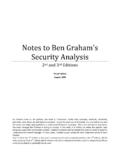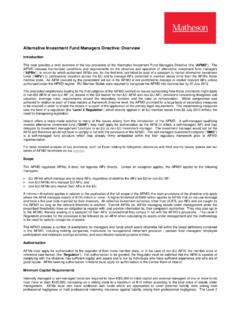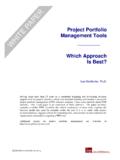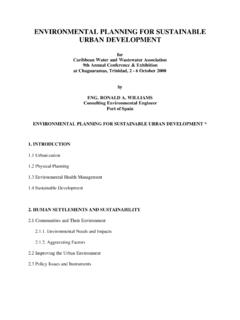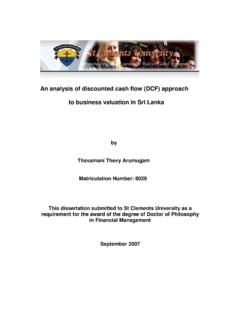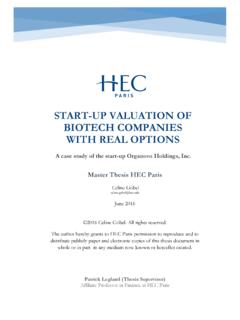Transcription of Berkshire Hathaway - vinodp.com
1 April 2010 Vinod Palikala Berkshire Hathaway Business Analysis and Valuation Business Analysis and Valuation by Vinod Palikala 2 Contents 1. Company Overview .. 3 2. Valuation Approach .. 4 3. Valuation .. 6 Insurance .. 7 Utilities and Energy .. 12 Manufacturing, Service and Retail .. 13 Finance and Financial Products .. 14 Total Company Valuation .. 15 4. Alternative Valuation Methods .. 15 Book Value Growth .. 16 Look Through Earnings.
2 17 Two Column Approach .. 17 5. Recommendation .. 18 Appendix .. 20 Float Value Calculation .. 20 Business Analysis and Valuation by Vinod Palikala 3 1. Company Overview Berkshire Hathaway is a unique collection of diverse business operating in a variety of industries. Management segregates the business into the segments illustrated in the diagram below. Berkshire is best viewed as a diversified conglomerate. However, it is managed on an extraordinarily decentralized basis with no centralized business processes like human resources or sales.
3 The only centralized functions are capital allocation and selection of Chief Executive for each of the operating businesses. There is no attempt made to create synergies between the individual businesses. Profits from each of the businesses flow back to the parent company where it is allocated opportunistically to earn high rates of return. Insurance Berkshire s insurance operations are carried out under four subsidiaries (1) GEICO (2) General Re (3) Berkshire Hathaway Reinsurance Group and (4) Berkshire Hathaway Primary Group.
4 The main business of Berkshire is insurance and is the dominant driver of the company value. Utilities & Energy Berkshire owns 90% of MidAmerican Energy Holdings Company. MidAmerican has several operating units (1) PacifiCorp (2) MidAmerican Energy Company (3) Northern Natural Gas Company (4) Kern River Gas Transmission Company (5) CE Electric (6) CalEnergy (7) HomeServices of America. Burlington Northern Santa Fe railroad acquired in 2010 is also part of this group. Manufacturing, Service & Retail This segment consists of very diverse group of businesses the most significant of which are (1) 64% ownership of Marmon (2) Shaw Industries (3) McLane (4) 80% ownership of ISCAR Metalworking Companies (5) FlightSafety International (6) NetJets.
5 Finance & Finance Products This consists of four main units (1) Clayton Homes (2) XTRA Corporation (3) BH Finance (4) CORT. Business Analysis and Valuation by Vinod Palikala 4 2. Valuation Approach Berkshire Hathaway is best valued using a sum of parts approach valuing individual business segments using methods appropriate for each. Many of the standard measures and methods of valuing stocks fail when applied to consolidated financial statement data of Berkshire . In particular, reported earnings and price to earnings ratios mislead investors since they do not adequately reflect the earning power of the investment portfolio while incorporating economically unimportant short term price swings of the derivative contracts.
6 Insurance companies can be thought of as earning money in two separate ways (a) underwriting side what the business earns from the premiums received after payment of all claims along with associated expenses (b) investment side what the business earns on its investments which include both the funds provided by insurer s own net worth and from the float generated by policy holder s premiums. The estimated earnings from both can then be used to calculate the estimated ROE. An appropriate multiple can then be applied to earnings or net tangible asset value based on the relative attractiveness of the ROE.
7 This traditional method is difficult to apply for calculating intrinsic value of Berkshire s insurance business due to the fact that the vastly overcapitalized insurance segment is often used to fund acquisition of businesses that makes it difficult to accurately evaluate historical returns on equity. For example, the $6 billion in investment in American Express stock is carried as part of investments on the insurance side and is available for use to meeting any policyholder claims. However, if Berkshire purchases the whole of American Express, then it becomes a wholly owned subsidiary but would not be available to meet policy holder s claims.
8 Thus as additional value is being created on the wholly owned segment, the excess capital tied up on the insurance segment while waiting for these investments reduces the return on equity on the insurance side. An estimate using this method would be made but it should be understood that this underestimates the true intrinsic value by penalizing the overcapitalized insurance segment. This might be the main cause of underestimation of Berkshire s intrinsic value by analysts. One approach to valuing the insurance business that seems to be supported by Buffett and used by Alice Schroeder in her 1999 report is to view the intrinsic value as a sum of the net tangible assets and the estimated value of float.
9 This would be the primary approach used to value the insurance segment in this report. The specific mechanics of valuing float would be detailed in the section valuing the insurance segment. The other segments are best valued using an estimate of normalized earning power along with an appropriate earnings multiple to account for their dependence on the business cycle and presence of any competitive moat by the business. Business Analysis and Valuation by Vinod Palikala 5 In calculating intrinsic value, I would attempt to separate out the investment component value demonstrated by weight of historical evidence in terms of actual results from the speculative component value which has a reasonably chance of occurring in the future but cannot be reliably expected to occur.
10 As this has significant implications for the buy, sell or hold decision for the investor, I would present the underlying rationale for the investor to fine tune their own estimates of investment and speculative components of value. Intrinsic value is by no means limited to the investment component of total value but may properly include a substantial component of speculative value, provided that such speculative value is intelligently arrived at. Hence market price may be said to exceed intrinsic value only when the market price is clearly the reflection of unintelligent speculation.
